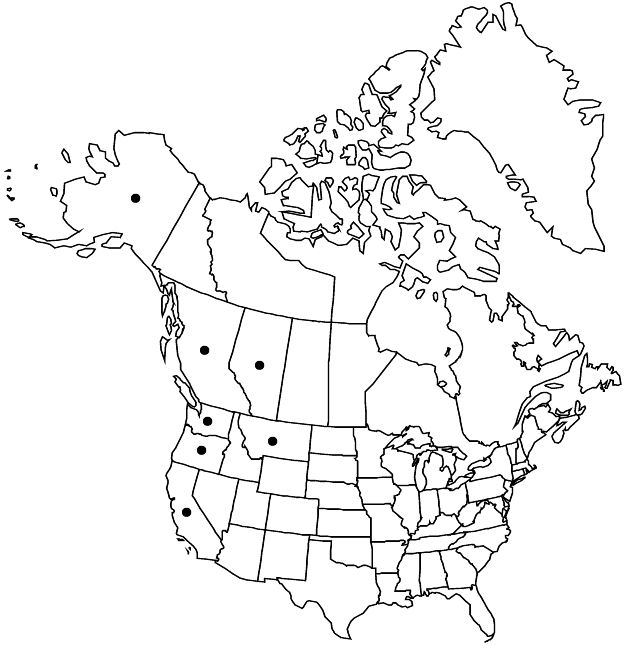Difference between revisions of "Potentilla drummondii"
Nov. Stirp. Pug. 2: 9. 1830.
FNA>Volume Importer |
FNA>Volume Importer |
(No difference)
| |
Revision as of 23:10, 16 December 2019
Glands usually absent or inconspicuous, rarely conspicuous, uncolored. Stems decumbent to nearly erect, 1.5–4.5(–6) dm. Basal leaves sometimes 2-ranked, subpinnate to pinnate (proximal leaflets often doubled, distal leaflets confluent and/or decurrent), (4–)10–25 cm; petiole 1–10(–15) cm, long hairs absent or sparse to abundant, appressed, 1–1.5 mm, usually stiff, short, crisped, and cottony hairs usually absent, glands absent or (regionally) abundant; leaflets 5–9, on distal 1/10–1/2(–3/4) of leaf axis, separate to ± overlapping, largest ones obovate to cuneate, (1–)2–5 × (0.7–)1–3(–3.5) cm, margins flat, distal 1/2–3/4 unevenly, sometimes evenly, incised ± 1/2 to midvein (often with additional incisions nearly to midvein), undivided medial blade 3–15 mm wide, teeth 3–7 per side (sometimes secondarily toothed), linear to lanceolate, 3–10 mm, surfaces similar, green, not glaucous, long hairs nearly absent or sparse to common (sometimes restricted to abaxial veins), short, crisped, and cottony hairs usually absent, glands usually absent, sometimes regionally abundant. Cauline leaves 1–3. Inflorescences 3–15-flowered. Pedicels 1–3(–6.5) cm. Flowers: epicalyx bractlets lanceolate to narrowly elliptic, 3–5 × 1–1.6 mm, hairs usually sparse, appressed to ascending, glands usually absent, sometimes regionally sparse to common; hypanthium (3–)4–6(–7) mm diam.; sepals 5–10 mm, apex acute to acuminate; petals (6–)7–12 × 5–10 mm; filaments 2–3.5 mm, anthers 0.7–1 mm; carpels (20–)25–40, styles filiform above papillate-swollen base, 2–3 mm. Achenes 1.5–2 mm. 2n = 64, 92, 96, 98–108.
Phenology: Flowering summer.
Habitat: Moist to dry meadows and adjacent slopes, in conifer woodlands, alpine tundra communities
Elevation: 300–3000 m
Distribution

Alta., B.C., Alaska, Calif., Mont., Oreg., Wash.
Discussion
The present circumscription of Potentilla drummondii differs from that of B. Ertter (1992, 1993), which encompassed P. breweri and P. bruceae as varieties (see 28. P. bruceae discussion for details). The description above focuses on large, eglandular, subpinnate plants that occur in mountains from the central Sierra Nevada and northern Coast Ranges of California to the Olympic Peninsula of Washington, east to southern Alberta. At least some collections previously identified as P. glaucophylla (as P. diversifolia Lehmann) from the Kenai Peninsula in Alaska can be readily accommodated within this concept, as can collections from the Cabinet Mountains in Montana. The distinction between P. drummondii and subpalmate P. glaucophylla can be vague; in general, the proximalmost leaflets of P. glaucophylla are relatively small and often entire; in P. drummondii proximalmost leaflets are similar in size and dissection to other leaflets.
Pinnate-leaved regional variants merit further attention; in particular the smaller form described as Potentilla cascadensis, and glandular plants in the northern Coast Ranges of California. Relatively small plants forming uniform populations in the southern Sierra Nevada may represent stabilized hybrids with P. breweri.
The inclusion of Potentilla bruceae and P. drummondii in sect. Graciles differs from that of J. Clausen et al. (1940) and B. C. Johnston (1980, 1985), who allied both species with P. breweri in sect. Multijugae. Although subpalmate to subpinnate leaves are anomalous in primarily palmate sect. Graciles, doubled proximal leaflets and an indistinct transition between the rachis and axis of the pinnatisect terminal leaflet in these two species suggest that this state is derived from a palmate progenitor. Habit and petioles also are more compatible with sect. Graciles than sect. Multijugae.
Selected References
None.